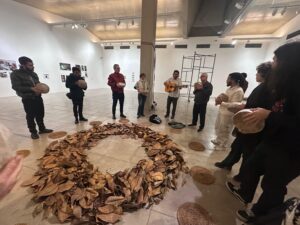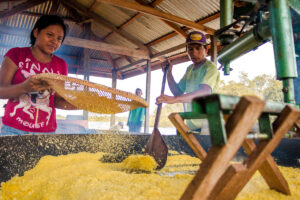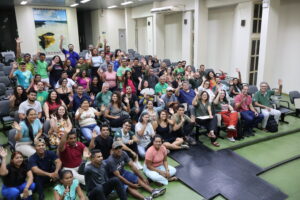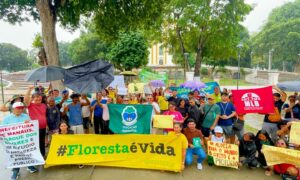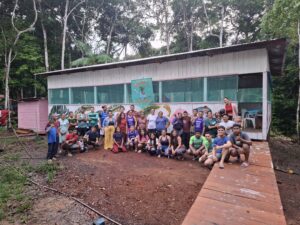During a 10-day immersion, representatives from seven communities belonging to the Association of Agroextractive Residents of Lower Médio Juruá (AMAB) experienced the Oasis Game, a social technology that mobilizes local talents, strengthens community bonds, and turns collective dreams into concrete actions.
By Raphael Chicayban
In a groundbreaking initiative in the region, Instituto Juruá and AMAB brought together representatives from seven communities (Marapatá, Lago Serrado, Marizal, Santa Cruz, Concórdia, Bacaba and São João) that are part of the association, to participate in a 10-day immersion in the Oasis Game — an innovative social transformation methodology created by Instituto Elos.
The preparation for the activity was careful and involved months of coordination. Since the AMAB Assembly, held in March, the communities had been mobilized to participate in the game and were filled with anticipation and curiosity about what the experience would be like. The atmosphere was one of discovery from the very beginning — and for many, what they experienced at Lago do Surara was much deeper than they had imagined.

Our adventure began even before we arrived at the Community-Based Private Protected Area of the Lower Médio Juruá; it was still on the boat, at the very start of our journey, that the players reconnected or met for the first time. Along the way, we passed through several communities, reaching out to local participants for the Oasis Game activity. During that moment, everyone on the boat was gradually getting to know one another, still with shy glances, unaware that the experience would be so transformative and would create so many bonds.


The Oasis is a community mobilization game that activates local talents and resources to transform people and environments through the realization of collective dreams. Known for its ability to foster development through citizen protagonism, the Oasis enables communities to propose creative responses to their challenges, reinforcing the spirit of cooperation and broadening the basis for participatory public policies. In addition to community members, the game also included the participation of representatives from the Tourism Management program at UEA (State University of Amazonas) and members of Instituto Juruá.
The activity aimed to strengthen the group’s sense of collective belonging and identity with regard to the Community-Based Private Protected Area of Lower Médio Juruá, through immersive experiences that combined affection, listening, hands-on work, and celebration. By recognizing local knowledge, dreaming together, and getting hands-on to transform the space, community members reaffirmed their autonomy, their relationship with the forest, and their ability to care for the present while collectively envisioning the future. The mobilization and sense of collectivity were already evident even before the game officially began. Upon arriving at the protected area, at Lago do Surara, everyone present helped each other carry all the materials, food, and bags ashore.
During the immersion, the participants took on a leading role in every stage, engaging in reflections about the territory, recognizing its strengths, and organizing themselves collaboratively for action.
The game is divided into several phases — seeing, affection, dreaming, care, hands-on, miracle, celebration, and re-evolution — which invite players to experience a complete cycle of transformation grounded in listening, welcoming, and collective achievement. Throughout the process, skills such as creativity, empathy, innovation, openness, collaboration, engagement, and a sense of collectivity were encouraged — fundamental elements that were already present in the communities but were strengthened throughout the journey.
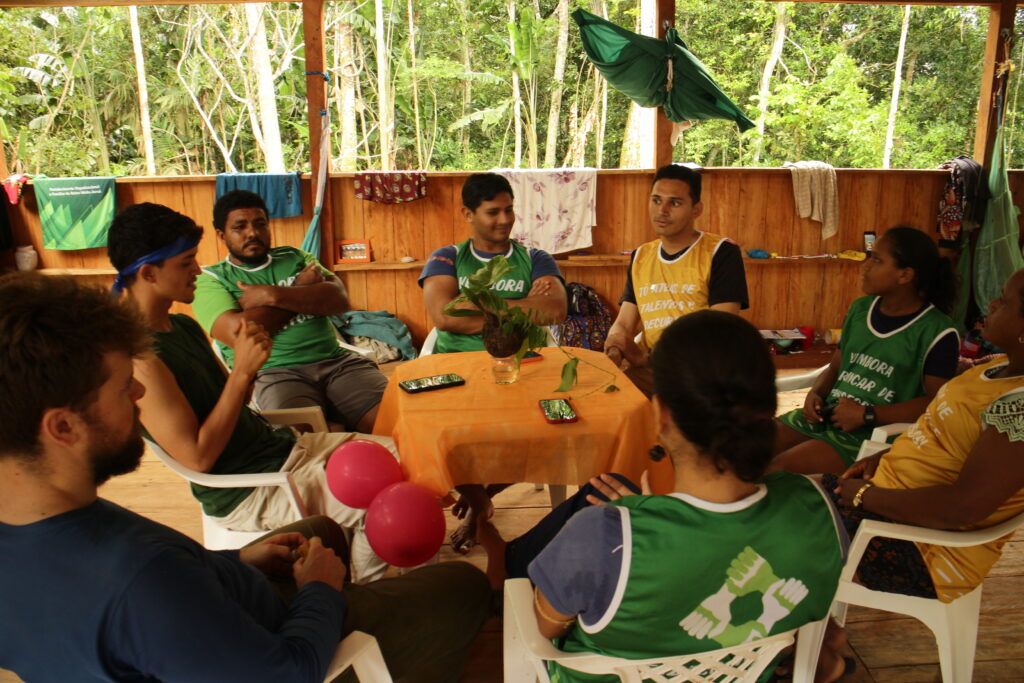
Unidos do Surara: dreams planted with feet on the ground and eyes blindfolded
The name, Unidos do Surara, chosen collectively, was the result of an emotional and powerful creation that sealed the group’s sense of unity during the Affection stage. Together, between laughter and singing, the participants composed an original song — a kind of anthem for the territory — woven with elements of the experience, the forest, and shared care. The song emerged as both a celebration and a symbol of belonging, bringing together diverse voices in a single rhythm, marked by the strength of collectivity and the beauty of the place they now recognize as both home and cause. In addition to the song, a banner holder was created, featuring elements that represented the group, using materials from local natural resources, such as sticks, leaves, and seeds.
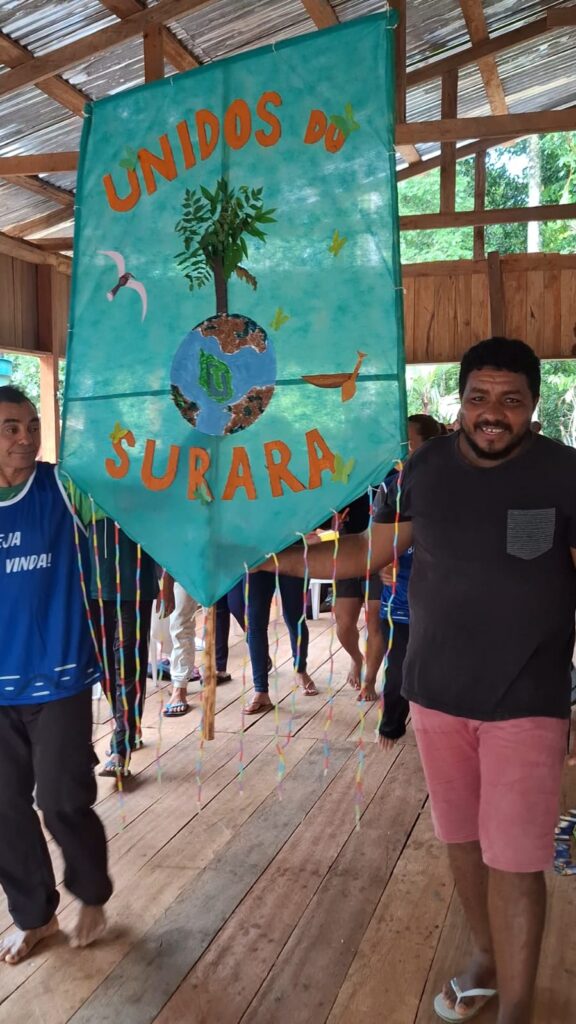
During an immersion filled with affection, belonging, and forest, Unidos do Surara transformed simple practices into powerful acts of care, memory, and reconstruction. The experience began with a blindfolded exercise — a practice of trust and connection that revealed much more than the absence of sight. There, words like “experience,” “security,” and “care” were not only spoken, but deeply felt in the body and the silence of the forest.
The mapping of beauties and resources during the “Look” stage awakened in the group the awareness of the importance of conserving the territory. The diversity encountered reinforced the connection between environmental protection and cultural and community strengthening. Amid the sound of the jacu bird and the wind in the igapó forest, the players mapped beauties and resources: seeds, Brazil nut trees, mushrooms, scents, animal tracks, trees, seeds, and fruits. Each detail, each name, carried the living identity of a standing, diverse, and fertile territory.
“We keep the forests for ourselves, right? We reserve it for ourselves. To prevent anyone from killing animals or cutting down the trees. We are fighting for this. […] We protect and know this place very well.” — Evandro Inácio, known as Seu Dira, resident of the Marapatá community.
In the dance between affection and action, the group revealed its talents: people who plant, fish, lead, carve, embroider, shoot arrows, work in education, care for the home, encourage, and listen. A living network of local skills intertwined with the stories of those who build this territory day after day.

From listening, dreams were born: interpretative trails, solar energy, clean water, community structures, and a shared desire to show the beauty of the place to the world. Collective dreams sketched with colored pencils and models, planned in circles, and then put into practice, with hands-on work and feet on the ground.

During the Care phase, the players returned to their communities to mobilize and gather human and financial resources, focusing on the selected collective dreams that involved renovating the community house, the cultural center, and creating the first interpretive trail — initial steps to improve the base infrastructure for lodging and activities on site, as well as to strengthen communal life, boost community-based tourism, and value local knowledge.
Throughout the game, the participants were able to create deep relationships with one another, listening to stories and affections, sharing experiences, and reflecting on how these exchanges could be essential to making their dreams come true. This collective movement revealed a reciprocal strength among leaders, who took on an even stronger protagonism within their communities.
“But when everyone comes together to develop a project, it’s a different feeling. Here, we’re seeking to learn from each person. Each one showing what they know, what they like to do. […] When you say ‘we,’ it means a lot to me. There are more people around us doing the same with love. And if there is happiness in what you’re doing, you can do everything well.” — José Alves, known as Silas, resident of the Lago Serrado community and Community Management Specialist at Instituto Juruá.
During the Milagre phase — the name given to the phase of project implementation — the group opened trails, built, painted, repaired, organized collective efforts, and ended the nights with communal dinners and buckets of açaí (a popular Amazonian fruit pulp). The celebration came as recognition: of what each person did, what the group built, and all the hands that contributed — including those who donated money or materials.
Re-Evolution remained as a horizon. Four dreams were chosen for the coming months: to create a dock at Lago Tambaqui, strengthen community surveillance, install a solar panel with internet access, and transform the community center into a space for hosting trainings such as courses, workshops, and initiatives similar to the Oasis game itself.
The Oasis Game experience at Lago do Surara not only mobilized people and communities around a collective dream — it also sparked intimate rediscoveries, reconnections with ancestry, and profound personal transformations. Each participant took home more than memories: they carried with them a new way of seeing themselves, others, and the territory.
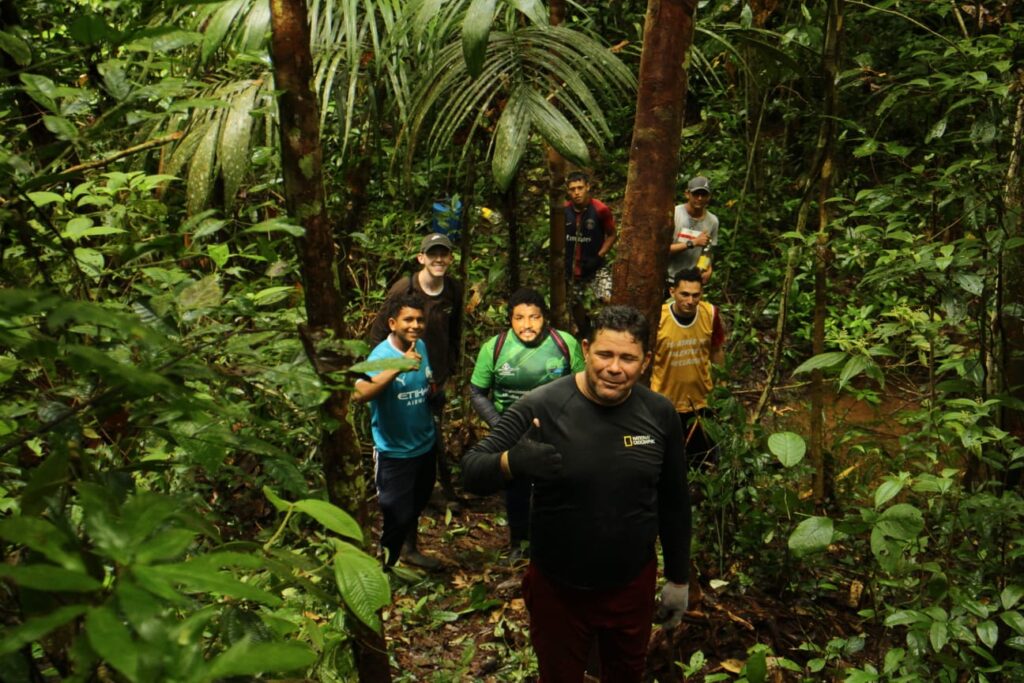
For many, Oasis was a symbolic journey. A process of leaving behind fears, shyness, and emotional overload to reconnect with community strength and the value of listening. People who had previously hesitated to express themselves began to feel confident speaking in public, sharing knowledge, and positioning themselves as protagonists in their communities. The process of welcoming, the conversation circles, the exchanged affection, and the intense days of living together created the necessary environment for courage, self-esteem, and belonging to emerge.
“And with everything that happened here, I also learned. I didn’t stand out speaking like I am speaking now, right? […] And today I’m here, thanks to the Oasis game. I gradually lost my shyness.” — Antonia Lijanete, resident of the Concórdia community.
Other participants shared that the game helped them reconnect with their own origins, revisiting childhood memories and recognizing the cultural and spiritual strength of the shared spaces. The interaction between communities that, although close, rarely have the time to meet deeply, allowed the emergence of stronger bonds based on care, active listening, and mutual appreciation. The territory ceased to be just a landscape and became a mirror — reflecting stories of struggle, overcoming, beauty, and resistance.
“It was an activity of rediscovery for me […] of everything I was as a girl, of everything I am and of something I know is truly mine. […] The Fernanda leaving here now is a Fernanda who understands who she is.” — Fernanda Moraes, president of AMAB, Community-Based Protected Area Manager at Instituto Juruá, and resident of the Lago Serrado community.
For the youth, the game awakened a new perspective on the reality around them. Many mentioned that, despite studying or living close to the forest, they had never stopped to notice certain details, nor understood the strength of community relationships as they felt there. The intergenerational interaction — with children, young people, and adults sharing the same space for exchange — provided fertile ground for learning and for strengthening emerging leadership.
“This was a unique experience, where I built a dream together with people from communities around me, and we made this dream come true together because, like I always say, one person can’t do anything alone, but with many people, it always works out.”— Dalton Menezes, Tourism Management student at UEA – Carauari campus.
In the voices and forests of Surara, in the simple gestures of daily life and the small victories of each activity, a powerful pedagogy was revealed: that dreaming together is the first step toward transforming realities. And that true wealth lies in people, in the living memory carried in their bodies, and in the wisdom they share with one another.

What took place in Surara was more than just a game. It was a rite of passage, a journey of healing, and a declaration of the future — one that can only be built collectively. Each person left transformed in their own way, but with something in common: the certainty that the territory beats stronger when it is cared for not only with the eyes, but with the heart.

